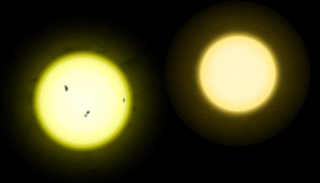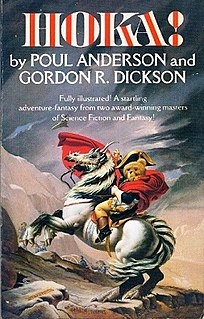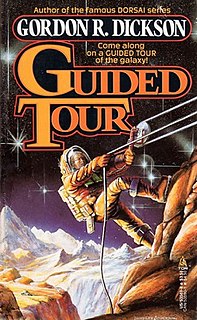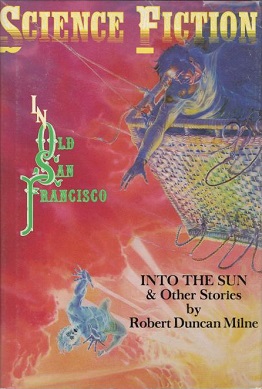"Love Is the Plan the Plan Is Death" is a short story by James Tiptree, Jr., a pen name used by American writer Alice Sheldon. The novella won a Nebula Award for Best Short Story in 1973. It first appeared in the anthology The Alien Condition, edited by Stephen Goldin, published by Ballantine Books in April 1973.

Planetary romance is a subgenre of science fiction in which the bulk of the action consists of adventures on one or more exotic alien planets, characterized by distinctive physical and cultural backgrounds. Some planetary romances take place against the background of a future culture where travel between worlds by spaceship is commonplace; others, particularly the earliest examples of the genre, do not, and invoke flying carpets, astral projection, or other methods of getting between planets. In either case, it is the planetside adventures which are the focus of the story, not the mode of travel.

The Two of Them is a feminist science fiction novel by Joanna Russ. It was first published in 1978 in the United States by Berkley Books and in Great Britain by The Women's Press in 1986. It was last reissued in 2005 by the Wesleyan University Press with a foreword by Sarah LeFanu.

The planetary systems of stars other than the Sun and the Solar System are a staple element in much science fiction. Sirius, a double star system with the binary designation Sirius AB, is the brightest stellar object in the night sky. Its component stars are Sirius A and Sirius B.

As one of the brightest stars in Earth's night sky, and the closest-known star system to the Sun, the Alpha Centauri system plays an important role in many fictional works of literature, popular culture, television, and film.

Tau Ceti is a star that hosts a planetary system and a common locale in much science fiction. It is the second closest spectral class G star to the Sun, making it a popular story setting or system of origin in science fiction tales. The Sun, itself of spectral class G, provides an obvious model for the possibility that the star might harbor worlds capable of supporting life. But Tau Ceti, weighing in at ~0.78 M☉, is metal-poor and so is thought to be unlikely to host rocky planets ; on the other hand, observations have detected more than ten times as much dust around the star than exists in the Solar System, a condition tending to enhance the probability of such bodies. Since the star's luminosity is barely 55% that of the Sun, those planets would need to circle it at the orbital radius of Venus in order to match the insolation received by the Earth.
Rigel is one of the brightest stars in the sky, usually the brightest star in the constellation Orion. It is frequently mentioned in works of fiction.

The planetary systems of stars other than the Sun and its Solar System are a staple element in much science fiction. Vega is a blue-white star in the constellation Lyra that is frequently featured in works of science fiction. Like its bright cousins Sirius, Deneb, and Altair, it is classified as a star of spectral type A. Roughly two and a half times the size of the sun, it is 40 times as luminous and, together with Arcturus and Sirius, one of the most radiant stars in the galactic neighborhood. Its luminosity joins with its relative proximity to the Earth—it is only 25 light-years away—to make it the fifth-brightest star in the night sky. Vega is rendered decidedly oblate by its rapid rate of rotation, and since it is pole-on to the sun, it appears significantly larger to earthbound observers than it actually is. For this and a variety of other reasons Vega has been extensively studied by astronomers, leading it to be termed "arguably the next most important star in the sky after the sun."
Altair is a luminous white star in the constellation Aquila frequently featured in works of science fiction.

Aldebaran is a type K5 giant star in the constellation Taurus that is frequently featured in works of science fiction. Aldebaran is a subject for ancient myths in multiple cultures and, in more recent times, the mythologizing of science fiction.

The planetary systems of stars other than the Sun and the Solar System are a staple element in much science fiction. Epsilon Eridani is the fifth-brightest star in the riverine southern constellation of Eridanus. An orange star slightly smaller and less massive than the Sun, and relatively close to the Solar System, it is frequently featured in works of science fiction. It is classified as a type K2 star, with the corresponding suggestion that it has a stable habitable zone and is well suited for life. However, one factor which weakens the case for habitability is its youth—it's as little as 200 million years old—and consequent high levels of ultraviolet emission.
Stars outside of our Solar System and their planets have been featured as settings in works of fiction since at least the 1854 novel Star ou Psi de Cassiopée by C. I. Defontenay, which depicts aliens living in the planetary system around Psi Cassiopeiae. A handful of works depict lifeforms not around but rather on or even inside of stars, such as the 1980 novel Dragon's Egg by Robert L. Forward and the 1993 novel Flux by Stephen Baxter, respectively; in both of these stories, the stars in question are neutron stars. Isaac Asimov's 1941 short story "Nightfall" portrays a planet in a multiple star system which is consequently in daylight from at least one of its suns for millennia at a time.
A significant number of science fiction works have explored the imaginative possibilities of binary or multiple star systems. Many real stars near the Sun belong in this category.

Hoka! is a collection of science fiction stories by American writers Poul Anderson and Gordon Dickson. It was first published by Wallaby in 1983. The stories originally appeared in the magazines Fantasy and Science Fiction and Analog Science Fiction and Fact.

Guided Tour is a collection of science fiction stories by American writer Gordon R. Dickson. It was first published by Tor Books in 1988. Most of the stories originally appeared in the magazines Fantasy and Science Fiction, Astounding, Planet Stories, Analog Science Fiction and Fact, Future, Science Fiction Stories, If, Galaxy Science Fiction, Imagination, Fantastic Universe and Fantastic Story Magazine.

Mars Mountain is a collection of science fiction short stories by Eugene George Key. It was first published in 1935 by Fantasy Publications. It is the first full length book to be issued by a publisher that specialized in science fiction.

Science Fiction in Old San Francisco: Volume Two, Into the Sun & Other Stories is a collection of science fiction short stories by Robert Duncan Milne and edited by Sam Moskowitz. It was first published in 1980 by Donald M. Grant, Publisher, Inc. in an edition of 1,500 copies. All but one of the stories first appeared in the magazine The Argonaut. The other story, "A Question of Reciprocity" first appeared in the San Francisco Examiner. This book with its companion volume History of the Movement From 1854 to 1890 won a Pilgrim Award for its editor, Moskowitz, in 1981.

Dan Morgan was an English science fiction writer and a professional guitarist, mainly active as a writer from the early 1950s through the mid-1970s. In addition to his fiction, he wrote two manuals relating to his musical profession.

Take Back Plenty (1990), is a novel by British writer Colin Greenland, which won both major British science fiction awards, the 1990 British SF Association award and the 1991 Arthur C. Clarke Award, as well as being a nominee for the 1992 Philip K. Dick Award for the best original paperback published that year in the United States.















